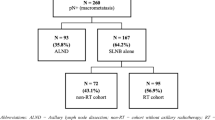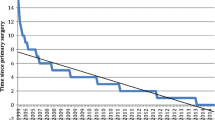Abstract
Axillary lymph node dissection (ALND) and radiation therapy (RT) are commonly recommended for mastectomy patients with positive sentinel lymph node biopsy (SLNB). Effective alternatives to ALND that reduce lymphedema risk are needed. We evaluated rates of lymphedema in mastectomy patients who received SLNB with RT, compared to ALND with or without RT. 627 breast cancer patients who underwent 664 mastectomies between 2005 and 2013 were prospectively screened for lymphedema, median 22.8 months follow-up (range 3.0–86.9). Each mastectomy was categorized as SLNB-no RT, SLNB + RT, ALND-no RT, or ALND + RT. RT included chest wall ± nodal radiation. Perometer arm volume measurements were obtained pre- and post-operatively. Lymphedema was defined as ≥10 % arm volume increase. Kaplan–Meier and Cox regression analyses were performed to determine lymphedema rates and risk factors. Of 664 mastectomies, 52 % (343/664) were SLNB-no RT, 5 % (34/664) SLNB + RT, 9 % (58/664) ALND-no RT, and 34 % (229/664) ALND + RT. The 2 year cumulative lymphedema incidence was 10.0 % (95 % CI 2.6–34.4 %) for SLNB + RT compared with 19.3 % (95 % CI 10.8–33.1 %) for ALND-no RT, and 30.1 % (95 % CI 23.7–37.8 %) for ALND + RT. The lowest cumulative incidence was 2.19 % (95 % CI 0.88–5.40 %) for SLNB-no RT. By multivariate analysis, factors significantly associated with increased lymphedema risk included RT (p = 0.0017), ALND (p = 0.0001), greater number of lymph nodes removed (p = 0.0006), no reconstruction (p = 0.0418), higher BMI (p < 0.0001) and older age (p = 0.0021). In conclusion, avoiding completion ALND and instead receiving SLNB with RT may decrease lymphedema risk in patients requiring mastectomy. Future trials should investigate the safety of applying the ACOSOG Z0011 protocol to mastectomy patients.

Similar content being viewed by others
References
Khan F, Amatya B, Pallant JF, Rajapaksa I (2012) Factors associated with long-term functional outcomes and psychological sequelae in women after breast cancer. Breast 21(3):314–320. doi:10.1016/j.breast.2012.01.013
Rief W, Bardwell WA, Dimsdale JE, Natarajan L, Flatt SW, Pierce JP (2011) Long-term course of pain in breast cancer survivors: a 4-year longitudinal study. Breast Cancer Res Treat 130(2):579–586. doi:10.1007/s10549-011-1614-z
Ahmed RL, Prizment A, Lazovich D, Schmitz KH, Folsom AR (2008) Lymphedema and quality of life in breast cancer survivors: the Iowa Women’s Health Study. J Clin Oncol 26(35):5689–5696. doi:10.1200/JCO.2008.16.4731
Sakorafas GH, Peros G, Cataliotti L, Vlastos G (2006) Lymphedema following axillary lymph node dissection for breast cancer. Surg Oncol 15(3):153–165. doi:10.1016/j.suronc.2006.11.003
Hayes SC, Janda M, Cornish B, Battistutta D, Newman B (2008) Lymphedema after breast cancer: incidence, risk factors, and effect on upper body function. J Clin Oncol 26(21):3536–3542. doi:10.1200/JCO.2007.14.4899
Jager G, Doller W, Roth R (2006) Quality-of-life and body image impairments in patients with lymphedema. Lymphology 39(4):193–200
DiSipio T, Rye S, Newman B, Hayes S (2013) Incidence of unilateral arm lymphoedema after breast cancer: a systematic review and meta-analysis. Lancet Oncol 14(6):500–515. doi:10.1016/S1470-2045(13)70076-7
Wernicke AG, Goodman RL, Turner BC, Komarnicky LT, Curran WJ, Christos PJ, Khan I, Vandris K, Parashar B, Nori D, Chao KS (2011) A 10-year follow-up of treatment outcomes in patients with early stage breast cancer and clinically negative axillary nodes treated with tangential breast irradiation following sentinel lymph node dissection or axillary clearance. Breast Cancer Res Treat 125(3):893–902. doi:10.1007/s10549-010-1167-6
McLaughlin SA, Wright MJ, Morris KT, Giron GL, Sampson MR, Brockway JP, Hurley KE, Riedel ER, Van Zee KJ (2008) Prevalence of lymphedema in women with breast cancer 5 years after sentinel lymph node biopsy or axillary dissection: objective measurements. J Clin Oncol 26(32):5213–5219. doi:10.1200/JCO.2008.16.3725
Wilke LG, McCall LM, Posther KE, Whitworth PW, Reintgen DS, Leitch AM, Gabram SG, Lucci A, Cox CE, Hunt KK, Herndon JE 2nd, Giuliano AE (2006) Surgical complications associated with sentinel lymph node biopsy: results from a prospective international cooperative group trial. Ann Surg Oncol 13(4):491–500. doi:10.1245/ASO.2006.05.013
Mansel RE, Fallowfield L, Kissin M, Goyal A, Newcombe RG, Dixon JM, Yiangou C, Horgan K, Bundred N, Monypenny I, England D, Sibbering M, Abdullah TI, Barr L, Chetty U, Sinnett DH, Fleissig A, Clarke D, Ell PJ (2006) Randomized multicenter trial of sentinel node biopsy versus standard axillary treatment in operable breast cancer: the ALMANAC Trial. J Natl Cancer Inst 98(9):599–609. doi:10.1093/jnci/djj158
Langer I, Guller U, Berclaz G, Koechli OR, Schaer G, Fehr MK, Hess T, Oertli D, Bronz L, Schnarwyler B, Wight E, Uehlinger U, Infanger E, Burger D, Zuber M (2007) Morbidity of sentinel lymph node biopsy (SLN) alone versus SLN and completion axillary lymph node dissection after breast cancer surgery: a prospective Swiss multicenter study on 659 patients. Ann Surg 245(3):452–461. doi:10.1097/01.sla.0000245472.47748.ec
Coen JJ, Taghian AG, Kachnic LA, Assaad SI, Powell SN (2003) Risk of lymphedema after regional nodal irradiation with breast conservation therapy. Int J Radiat Oncol Biol Phys 55(5):1209–1215
Hayes SB, Freedman GM, Li T, Anderson PR, Ross E (2008) Does axillary boost increase lymphedema compared with supraclavicular radiation alone after breast conservation? Int J Radiat Oncol Biol Phys 72(5):1449–1455. doi:10.1016/j.ijrobp.2008.02.080
Giuliano AE, Hunt KK, Ballman KV, Beitsch PD, Whitworth PW, Blumencranz PW, Leitch AM, Saha S, McCall LM, Morrow M (2011) Axillary dissection vs no axillary dissection in women with invasive breast cancer and sentinel node metastasis: a randomized clinical trial. J Am Med Assoc 305(6):569–575. doi:10.1001/jama.2011.90
Giuliano AE, McCall L, Beitsch P, Whitworth PW, Blumencranz P, Leitch AM, Saha S, Hunt KK, Morrow M, Ballman K (2010) Locoregional recurrence after sentinel lymph node dissection with or without axillary dissection in patients with sentinel lymph node metastases: the American College of Surgeons Oncology Group Z0011 randomized trial. Ann Surg 252(3):426–432. doi:10.1097/SLA.0b013e3181f08f32 discussion 432-423
Haffty BG, Hunt KK, Harris JR, Buchholz TA (2011) Positive sentinel nodes without axillary dissection: implications for the radiation oncologist. J Clin Oncol 29(34):4479–4481. doi:10.1200/JCO.2011.36.1667
Ancukiewicz M, Russell TA, Otoole J, Specht M, Singer M, Kelada A, Murphy CD, Pogachar J, Gioioso V, Patel M, Skolny M, Smith BL, Taghian AG (2011) Standardized method for quantification of developing lymphedema in patients treated for breast cancer. Int J Radiat Oncol Biol Phys 79(5):1436–1443. doi:10.1016/j.ijrobp.2010.01.001
Miller CL, Specht MC, Horick N, al e (2013) A novel, validated method to quantify breast-cancer related lymphedema (BCRL) following bilateral breast surgery. Lymphology 46:64–72
Armer JM, Stewart BR (2005) A comparison of four diagnostic criteria for lymphedema in a post-breast cancer population. Lymphat Res Biol 3(4):208–217. doi:10.1089/lrb.2005.3.208
Tsai RJ, Dennis LK, Lynch CF, Snetselaar LG, Zamba GK, Scott-Conner C (2009) The risk of developing arm lymphedema among breast cancer survivors: a meta-analysis of treatment factors. Ann Surg Oncol 16(7):1959–1972. doi:10.1245/s10434-009-0452-2
Armer JM, Stewart BR, Shook RP (2009) 30-month post-breast cancer treatment lymphoedema. J Lymphoedema 4(1):14–18
Lee EW, Wei LJ, Amato D (1992) Cox-type regression analysis for large numbers of small groups of correlated failure time observations. Kluwer Academic, Amsterdam, pp 237–247
Recht A, Edge SB (2003) Evidence-based indications for postmastectomy irradiation. Surg Clinics North Am 83(4):995–1013. doi:10.1016/S0039-6109(03)00033-1
Eifel P, Axelson JA, Costa J, Crowley J, Curran WJ Jr, Deshler A, Fulton S, Hendricks CB, Kemeny M, Kornblith AB, Louis TA, Markman M, Mayer R, Roter D (2001) National Institutes of Health Consensus Development Conference Statement: adjuvant therapy for breast cancer, November 1–3. J Natl Cancer Inst 93(13):979–989
Harris JR, Halpin-Murphy P, McNeese M, Mendenhall NP, Morrow M, Robert NJ (1999) Consensus Statement on postmastectomy radiation therapy. Int J Radiat Oncol Biol Phys 44(5):989–990
Hinrichs CS, Watroba NL, Rezaishiraz H, Giese W, Hurd T, Fassl KA, Edge SB (2004) Lymphedema secondary to postmastectomy radiation: incidence and risk factors. Ann Surg Oncol 11(6):573–580. doi:10.1245/ASO.2004.04.017
Rutgers EJ, M. D, Straver ME, al e (2013) Radiotherapy or surgery of the axilla after a positive sentinel node in breast cancer patients: Final analysis of the EORTC AMAROS trial (10981/22023). In: Proceedings of the ASCO Annual Meeting; 2013 May 31–June 4; Chicago, IL. Journal of clinical oncology : official Journal of the American Society of Clinical Oncology 31 (suppl; abstr LBA1001)
Donker M, Rutgers EJ, van de Velde CJH, et al (2013) Axillary lymph node dissection versus axillary radiotherapy: A detailed analysis of morbidity. Results from the EORTC 10981-22023 AMAROS trial. European Cancer Congress; 2013 September 27-October 1; Amsterdam, Netherlands. Abstract #30
Shah C, Wilkinson JB, Baschnagel A, Ghilezan M, Riutta J, Dekhne N, Balaraman S, Mitchell C, Wallace M, Vicini F (2012) Factors associated with the development of breast cancer-related lymphedema after whole-breast irradiation. Int J Radiat Oncol Biol Phys 83(4):1095–1100. doi:10.1016/j.ijrobp.2011.09.058
Ahmed RL, Schmitz KH, Prizment AE, Folsom AR (2011) Risk factors for lymphedema in breast cancer survivors, the Iowa Women’s Health Study. Breast Cancer Res Treat 130(3):981–991. doi:10.1007/s10549-011-1667-z
Norman SA, Localio AR, Kallan MJ, Weber AL, Torpey HA, Potashnik SL, Miller LT, Fox KR, DeMichele A, Solin LJ (2010) Risk factors for lymphedema after breast cancer treatment. Cancer Epidemiol Biomarkers Prev 19(11):2734–2746. doi:10.1158/1055-9965.EPI-09-1245
Johansson K, Ohlsson K, Ingvar C, Albertsson M, Ekdahl C (2002) Factors associated with the development of arm lymphedema following breast cancer treatment: a match pair case-control study. Lymphology 35(2):59–71
Card A, Crosby MA, Liu J, Lindstrom WA, Lucci A, Chang DW (2012) Reduced incidence of breast cancer-related lymphedema following mastectomy and breast reconstruction versus mastectomy alone. Plast Reconstr Surg 130(6):1169–1178. doi:10.1097/PRS.0b013e31826d0faa
Avraham T, Daluvoy SV, Riedel ER, Cordeiro PG, Van Zee KJ, Mehrara BJ (2010) Tissue expander breast reconstruction is not associated with an increased risk of lymphedema. Ann Surg Oncol 17(11):2926–2932. doi:10.1245/s10434-010-1112-2
Stanton AW, Northfield JW, Holroyd B, Mortimer PS, Levick JR (1997) Validation of an optoelectronic limb volumeter (Perometer). Lymphology 30(2):77–97
Tierney S, Aslam M, Rennie K, Grace P (1996) Infrared optoelectronic volumetry, the ideal way to measure limb volume. Eur J Vasc Endovasc Surg 12(4):412–417
Stout Gergich NL, Pfalzer LA, McGarvey C, Springer B, Gerber LH, Soballe P (2008) Preoperative assessment enables the early diagnosis and successful treatment of lymphedema. Cancer 112(12):2809–2819. doi:10.1002/cncr.23494
Ancukiewicz M, Miller CL, Skolny MN, O’Toole J, Warren LE, Jammallo LS, Specht MC, Taghian AG (2012) Comparison of relative versus absolute arm size change as criteria for quantifying breast cancer-related lymphedema: the flaws in current studies and need for universal methodology. Breast Cancer Res Treat 135(1):145–152. doi:10.1007/s10549-012-2111-8
Acknowledgments
This project was supported by Award R01CA139118 (AGT) and Award P50CA089393 (AGT) from the National Cancer Institute. The content is solely the responsibility of the authors and does not necessarily represent the views of the National Cancer Institute or the National Institutes of Health. In addition, this work was partially supported by the Adele McKinnon fund for the Lymphedema Research Program at Massachusetts General Hospital.
Conflict of interest
The authors have no conflicts of interest to disclose.
Author information
Authors and Affiliations
Corresponding author
Additional information
Cynthia L. Miller and Michelle C. Specht contributed equally to this manuscript.
Rights and permissions
About this article
Cite this article
Miller, C.L., Specht, M.C., Skolny, M.N. et al. Risk of lymphedema after mastectomy: potential benefit of applying ACOSOG Z0011 protocol to mastectomy patients. Breast Cancer Res Treat 144, 71–77 (2014). https://doi.org/10.1007/s10549-014-2856-3
Received:
Accepted:
Published:
Issue Date:
DOI: https://doi.org/10.1007/s10549-014-2856-3




